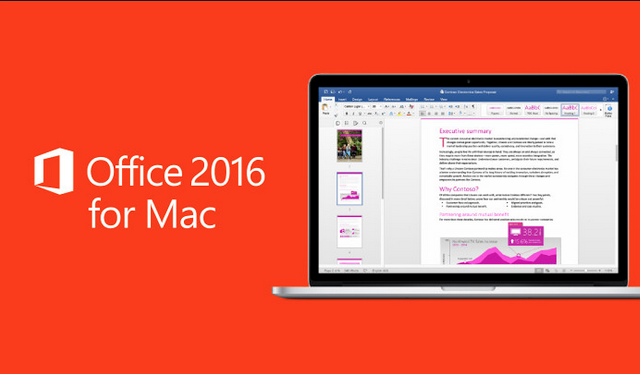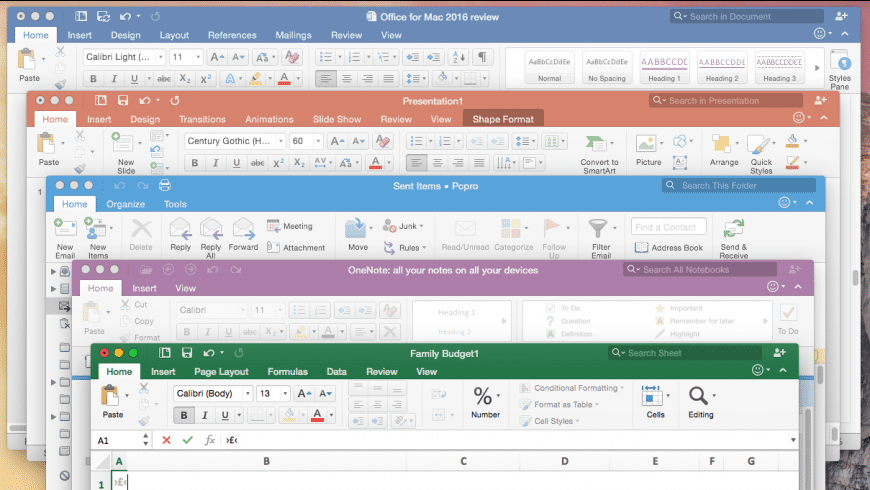Start quickly with the most recent versions of Word, Excel, PowerPoint, Outlook, OneNote and OneDrive —combining the familiarity of Office and the unique Mac features you love. Work online or offline, on your own or with others in real time—whatever works for what you’re doing.
Office apps are already running smooth on Apple's new Mac chips.
- Office 2019 for Mac, which includes new versions of Word, Excel, PowerPoint, Outlook, and OneNote, is the next perpetual update to Office for Mac and will ship alongside Office 2019 for Windows.
- Microsoft Office 2016 (codenamed Office 16) is a version of the Microsoft Office productivity suite, succeeding both Office 2013 and Office for Mac 2011, and preceding Office 2019 for both platforms. It was released on macOS on July 9, 2015 and on Microsoft Windows on September 22, 2015 for Office 365 subscribers. Mainstream support ends on October 13, 2020, and most editions have extended.
- Update Office from the Mac App Store. If you downloaded Office from the Mac App Store, and have automatic updates turned on, your apps will update automatically. But you can also manually download the updates: Open the Mac App Store from your Dock or Finder.
What you need to know
- Microsoft's Office apps are already up and running natively on Apple's new Mac silicon.
- Apple showed off Word, PowerPoint, and Excel in action during its WWDC 2020 presentation.
- The new Apple-designed chips will start shipping in Macs later this year.
At its WWDC 2020 conference today, Apple announced that it is preparing to start shipping its own processors in Macs. The move will see Apple silicon replace Intel and unite the full Apple ecosystem on one platform. That will require some work from developers to get their Mac apps transitioned to run on the new platform, but it looks like Microsoft is already among the earliest adopters.

During the segment focusing on the new chips, Apple showed off Microsoft Office apps running natively on a Mac using an Apple A12Z processor. The apps looked just like the desktop Office apps you're used to seeing today, and they ran as smooth as you could expect. Check out a demo of them in action below.
What Is The Latest Office For Mac
Microsoft has been in-step with big changes coming to Apple platforms in recent years. It was among the first to adopt iOS' dark mode support, for example. It's not a huge surprise to see Microsoft is early in making sure the Office apps are ready for this transition as well.

Apple says that it expects the first Mac using its own silicon to ship later this year. The full transition period, Apple estimated, will take about two years.
In other Microsoft-related news coming out of WWDC, Apple revealed that it is adding support for the Xbox Elite Controller Series 2 and Xbox Adaptive Controller with tvOS 14 later this year.
For more WWDC 2020 coverage, out sister site iMore has been hard at work compiling all of the announcements and everything you need to know.
How to get updates for macOS Mojave or later

If you've upgraded to macOS Mojave or later, follow these steps to keep it up to date:
- Choose System Preferences from the Apple menu , then click Software Update to check for updates.
- If any updates are available, click the Update Now button to install them. Or click ”More info” to see details about each update and select specific updates to install.
- When Software Update says that your Mac is up to date, the installed version of macOS and all of its apps are also up to date. That includes Safari, iTunes, Books, Messages, Mail, Calendar, Photos, and FaceTime.
To find updates for iMovie, Garageband, Pages, Numbers, Keynote, and other apps that were downloaded separately from the App Store, open the App Store on your Mac, then click the Updates tab.
What S The Latest Version Of Office For Mac
To automatically install macOS updates in the future, including apps that were downloaded separately from the App Store, select ”Automatically keep my Mac up to date.” Your Mac will notify you when updates require it to restart, so you can always choose to install those later.

How to get updates for earlier macOS versions
If you're using an earlier macOS, such as macOS High Sierra, Sierra, El Capitan, or earlier,* follow these steps to keep it up to date:
- Open the App Store app on your Mac.
- Click Updates in the App Store toolbar.
- Use the Update buttons to download and install any updates listed.
- When the App Store shows no more updates, the installed version of macOS and all of its apps are up to date. That includes Safari, iTunes, iBooks, Messages, Mail, Calendar, Photos, and FaceTime. Later versions may be available by upgrading your macOS.
To automatically download updates in the future, choose Apple menu > System Preferences, click App Store, then select ”Download newly available updates in the background.” Your Mac will notify you when updates are ready to install.
* If you're using OS X Lion or Snow Leopard, get OS X updates by choosing Apple menu > Software Update.
Latest Mac Software
How to get updates for iOS
Learn how to update your iPhone, iPad, or iPod touch to the latest version of iOS.
Latest Office For Mac 2011

Latest Mac Computer
Learn more
Office For Mac Update
- Learn how to upgrade to the latest version of macOS.
- Find out which macOS your Mac is using.
- You can redownload apps that you previously downloaded from the App Store.
- Your Mac doesn't automatically download large updates when it's using a Personal Hotspot.
